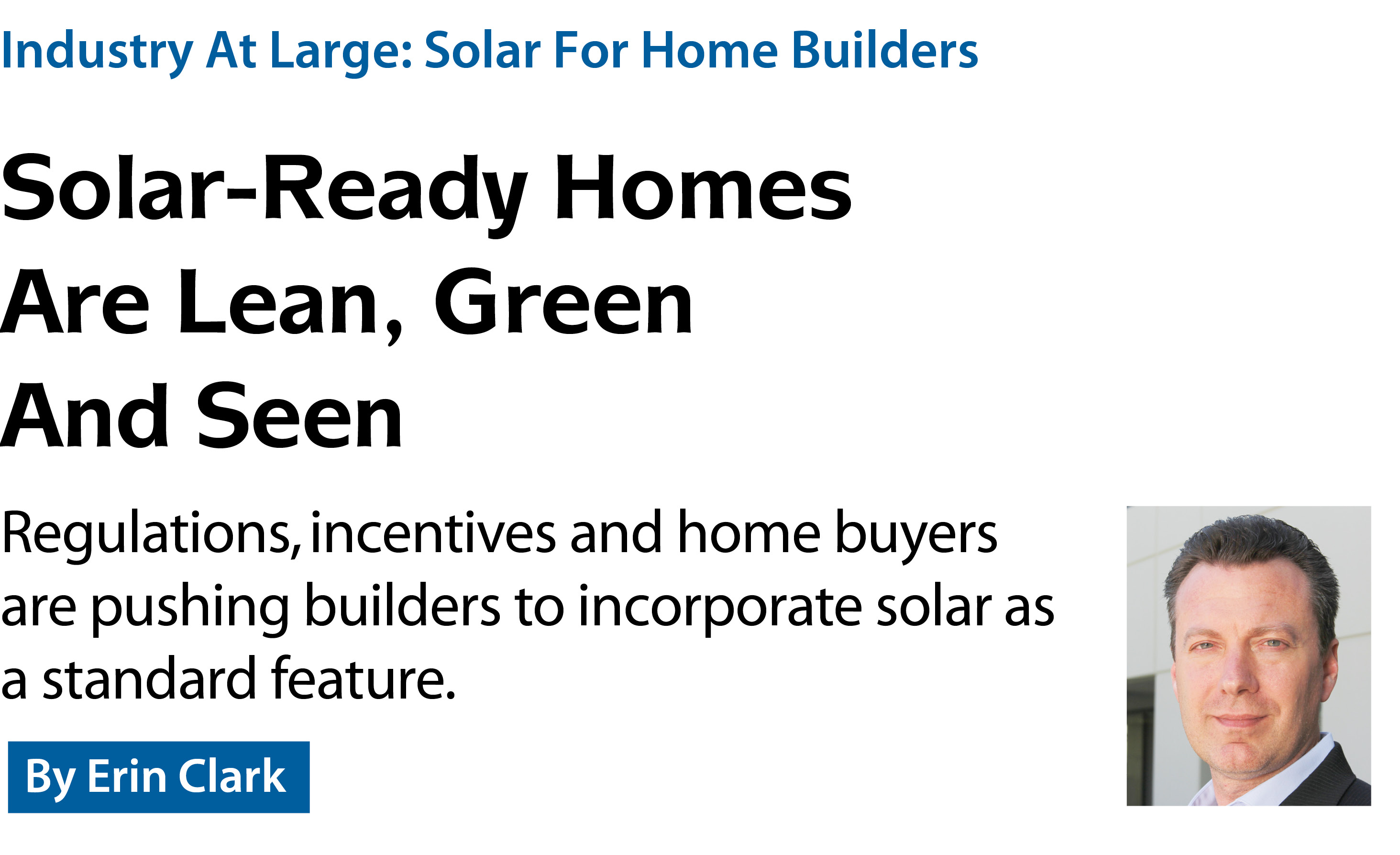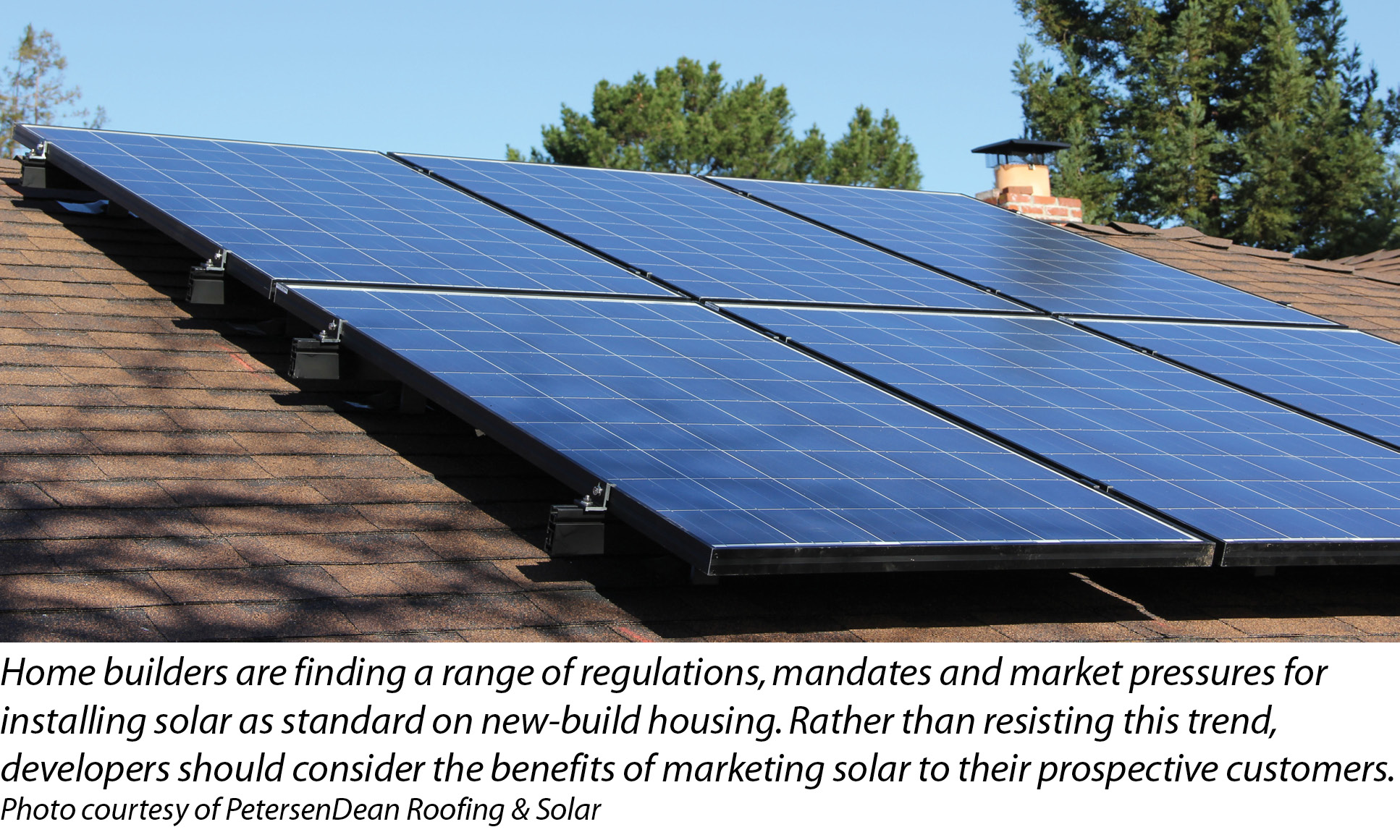

301 Moved Permanently
Everyone needs a little push now and again. Sometimes, we push ourselves because we see a need. Other times, we get a little nudge that compels us to change how we do things. Such is the case for building solar-ready communities to satisfy not only the requirements of local municipalities, but also the home buyers who demand them.
With California already holding builders to solar-ready regulations, and municipalities across the country mulling over the concept of solar-ready new home construction - while offering lucrative incentives to do so - it is expected that the trend toward standard solar will continue across all 50 states. In a classic case of “not if but when,” how can builders prepare and stay ahead of the solar curve?
Who requires solar-ready?
The solar-ready trend started in California with a mandate that new homes were all to be built “solar-ready.” The Golden State’s solar-ready mandate came to fruition in 2013, when the California Energy Commission required all new residential and commercial building to feature solar-ready roofs. This meant roofs must provide the space required for solar panel installation.
Although this may seem to not be a true mandate for solar panels to be installed on new home roofs, it does open up the possibility for builders to take advantage of rebates offered by local municipalities to do so. It also enables builders to install basic “starter” solar systems on California roofs with the option for homeowners to upgrade those systems. The markup for upgrades would be at the builders’ discretion, allowing a return on investment (ROI) for offering the basic system and possibly enhancing profits for those who opt for something more. Rebates further enhance opportunities for profit.
How can rebates stir builders to build solar-ready homes, even in areas where it is not yet required? In Oregon, where there is no current mandate, the Energy Trust of Oregon (ETO) created solar-ready incentives to compel builders and owners of new commercial buildings to make their structures solar-ready without having to fund the expense of the entire solar installation. The program features a system of rebates for builders that can add up to $20,000 in incentives.
Incentives aside, the fact that several states are even thinking about putting solar-ready requirements on the books should push builders to make the change, regardless of locale and energy rates. Even in states where electricity is relatively inexpensive, such as Texas, the idea of mandating solar-ready is already on the map. In 2014, the Texas A&M Energy Systems Lab (ESL) completed a mandated technical review and recommendation of the 2015 energy codes for the State Energy Conservation Office. Although solar-ready provisions were not specifically recommended by ESL, the idea about becoming solar-ready gained visibility within the market.
Mandates and incentives are just some of the reasons builders need to make solar-ready a part of the plan for new builds - but the most appealing reason to do so is the ROI for giving home buyers what they want and demand.

Be ahead of the solar curve
What exactly is the ROI for builders who build solar-ready? At PetersenDean, we know that the ROI for builders and developers is significant, because as the price of solar drops, and more communities offer solar as standard, the home buying customers will come to expect it.
Our recently opened new community with JMC Homes in Lincoln, Calif., offers all new homes with solar as standard. The community has 150 homes with a 1.5 kW Canadian Solar standard on every home. Home buyers then have the opportunity to upgrade to as much as 5 kW on their homes. This gives each home an estimated annual energy savings (with a 5 kW system) of about $1,700 annually, or $85 a month. Market to home buyers that tax credits totaling up to $2,500 are available if they have solar roofing, and the appeal of solar-ready only increases. We are working with several builders now that are offering solar as a standard feature in all homes, including D.R. Horton, KB Home, DeNova Homes, Far West Industries and Olson Homes to name a few.
Essentially, when builders offer solar-ready to their customers, tying in affordability and savings to the ever-expanding niche that demands solar, it becomes a win-win situation. Just as with the trend to offer granite countertops and stainless steel appliances began with one builder, solar will become an expected standard feature.
One can see how incentives work to bring solar into focus for builders in Oregon, where the ETO provides builders with funding that reduces installation costs of verified infrastructure for solar-ready systems. This incentive is $200 per home.
An additional reason to consider ROI on solar is that it is dropping in price, allowing builders to offer standard solar without having to add a lease, which can complicate the sale. The leasing contracts on the market have too many unknown clauses that could drive a potential homeowner to another builder that does not require a 20-year lease. Our approach is to only offer a purchase option to home builders. Add to this the current 30% federal tax credit, and solar becomes a lucrative offering for builders. Also, we coordinate with municipalities and utility companies in the builders’ new home community to meet the requirements for solar-ready, qualify for incentives and obtain rebates.
Communicating ROI to buyers
Builders must communicate the significant solar ROI to home buyers. It starts with promoting solar via the builder’s website, advertisements, television commercials and public relations efforts. Solar-ready, like the sun, is meant to shine.
Promoting the ROI to home buyers is also important, and the data is available to prove it. The GeoStellar Solar Index shows that solar is a wise investment that can generate more wealth for homeowners in much of the country than bonds, certificates of deposit (CDs) and other investments. In a total of 33 states, solar offers better ROIs than 30-year U.S. Treasuries. And in 43 states, solar offers better ROIs than five-year CDs, which typically return just 0.75% annually.
As electricity rates rise, so does interest in solar power. Homeowners usually want to see a comparison of the cost per kilowatt-hour for solar versus the price per kilowatt-hour being paid to the electric company - this is an average in tiered rate structures. The great thing about solar electricity is that calculating costs and savings can be done on a per-kilowatt-hour basis using simple division. From there, it is very easy to demonstrate lifetime savings and payback time frames for each customer.
Additionally, once a solar power system is paid off, it can add a tremendous amount of resale value to a home. People are keyed in to what solar energy does for their pocketbook and the efficiency of their home. If a buyer has to choose between a home that has low energy bills versus one that doesn’t, it’s a no-brainer. In addition, an increasing number of buyers looking to purchase new homes are opting for solar-ready residences.
The payback periods for homeowners with solar systems have also dropped significantly.
Everyone seems to be pushing green these days. With solar, the push is a winner because it also offers financial incentives to builders and home buyers, and it offers the very real idea of clean energy for a better future. Solar energy is trendy.
This energy conservation trend, however, isn’t going to fade away with Day-Glo and bell-bottom pants. A recent survey of 2,354 solar homeowners in the San Diego Gas & Electric territory revealed that 87% made a significant investment in energy conservation either before or after their solar system installation. Included was the replacement of energy-hogging fixtures and appliances, improvements in wall insulation, the weatherstripping of doors and windows, and the installation of cool roofs. These efforts to conserve are further matched by having a solar system on board that not only allows homeowners to reap the benefits of reduced energy costs, but gives builders the attention they want and need from home buyers looking for systems already installed in their new homes.
Builders who fulfill the need for green, clean energy by installing solar systems as standard in their new home communities set themselves apart from the pack. Being different - being green in this case - can prove beneficial not only when environmentally conscious home buyers come looking for your solar-ready properties, but when other builders see the difference you are making in the environment and your bottom line. If you want to be ahead of the trends, solar is the “it” that you must embrace.
When it comes to building environmentally responsible homes, we at PetersenDean believe that solar is a crucial component. As an installer of American-made solar products for residential customers since 1984, we have long been committed to powering American homes smarter. Not only does solar provide cleaner, cheaper energy for homeowners, but it is also advantageous from both an environmental and economic standpoint for the nation as a whole. And although incentives give builders a financial reason to make their builds solar-ready, it is the municipalities’ requirements for such infrastructure that makes it a must.
Like a domino effect, once a few key states go this route, the rest are likely to follow - which is why it’s best to be on top of your solar game. It is estimated that within 20 years, all new homes will be net-zero, energy-efficient clean machines. By making solar-ready a standard install now, with options for home buyers to upgrade their systems, you hit the 1-2-3 punch of giving buyers and municipalities what they demand, providing for a future of clean energy and promising financial incentives for doing so.
It looks like a bright and sunny day after all for builders who see solar for the shining opportunity it is.
Industry At Large: Solar For Home Builders
Solar-Ready Homes Are Lean, Green And Seen
By Erin Clark
Regulations, incentives and home buyers are pushing builders to incorporate solar as a standard feature.
si body si body i si body bi si body b
si depbio
- si bullets
si sh
si subhead
pullquote
si first graph
si sh no rule
si last graph